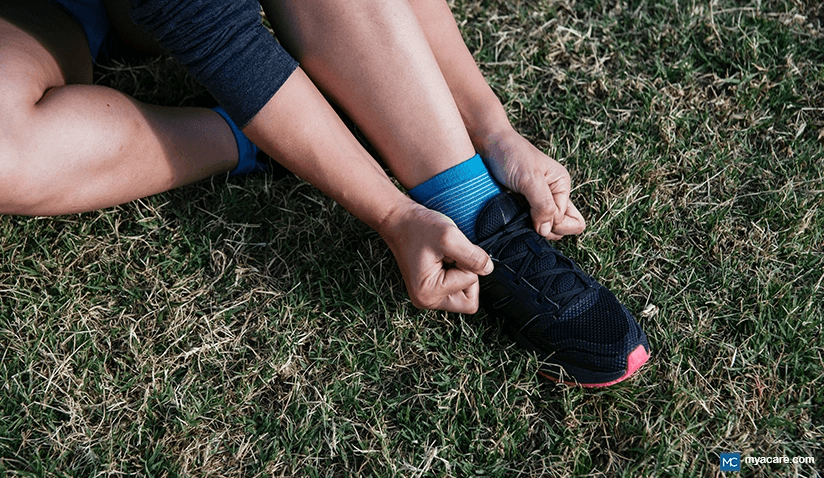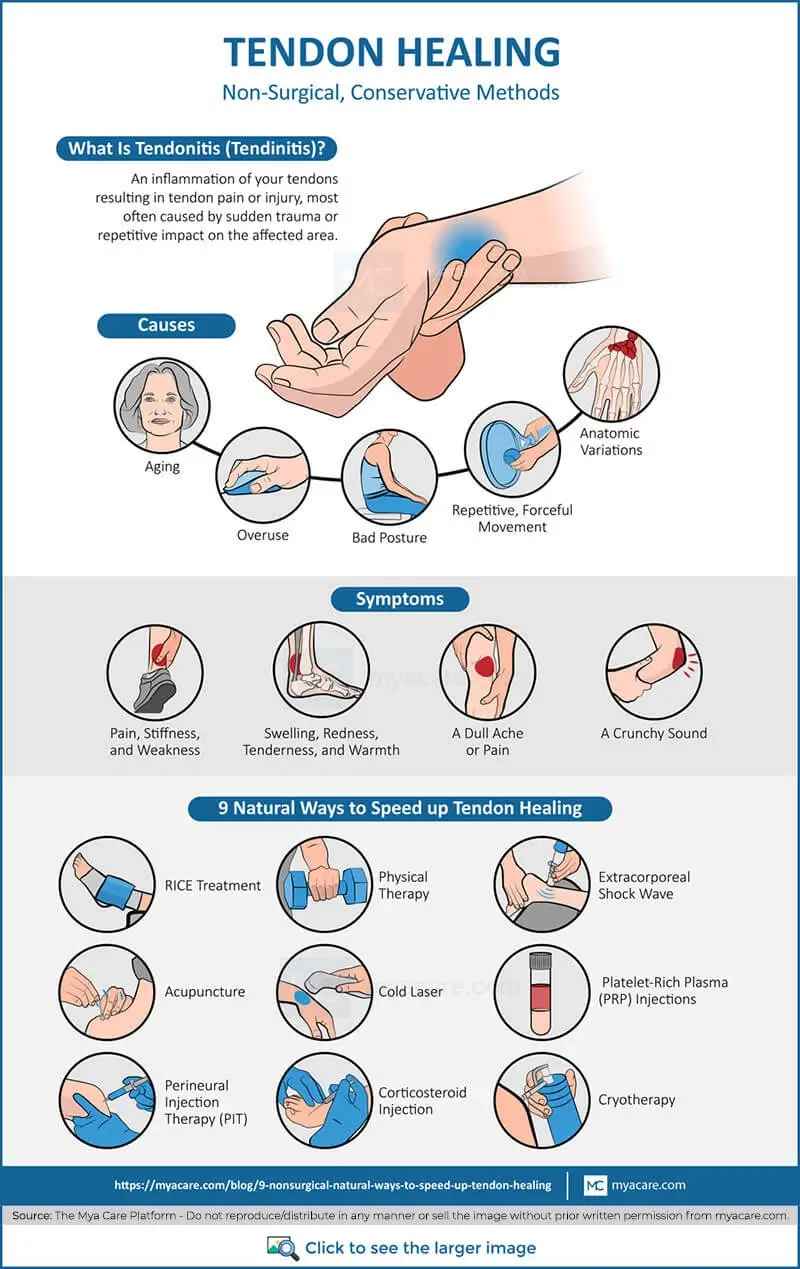9 Non-Surgical Natural Ways to Speed Up Tendon Healing

Updated 14 November 2023
Nearly 33 million tendon injuries are reported every year in the United States alone - That’s a huge number.
Tendonitis, also known as Tendinitis, can affect almost anyone. It’s a painful condition that can restrict your range of motion and affect your everyday activities. Tendon pain can be caused by wear and tear over time and repetitive actions that impact your tendons.
Tendonitis usually resolves with time; however, early treatment is essential to prevent worsening your tendon injury. The latest treatments in medicine have brought about natural, non-surgical treatments to reduce tendon pain and inflammation, improve your mobility, and speed up tendon healing.
Let’s explore the top 9 non-surgical ways to boost tendon healing!
What Is Tendonitis?
Your tendons are made up of connective tissue that connects your muscle to your bone. They facilitate joint movement by transmitting forces from your muscles to bones.
Tendonitis is the inflammation of your tendons, resulting in tendon pain or tendon injuries. It’s most often caused by sudden injury or repetitive impact on the affected area. Gradual wear and tear weaken your tendons over time and increase your risk of getting a tendon injury.
These are a few conditions that can cause tendonitis:
- Aging
- Overuse
- Bad posture
- Occupations with repetitive, forceful movement (woodworking, shoveling, scrubbing)
- Repetitive motions in sports (tennis, golf, baseball)
- Anatomic variations (limb or joint deformities)
Certain tendons are more prone to tendon injuries than others, including your Achilles tendon in your lower calf, the patellar tendon in your knee, the rotator cuff tendons in your shoulder, and the tibialis posterior tendon in the back of your leg, to name a few.
Tendonitis can affect all ages. Although, you become more susceptible as you get older because your tendons are less flexible and more prone to injury.
Here are some common types of tendonitis:
- Rotator cuff tendinopathy
- Pain in the shoulder joint
- Tennis elbow
- Rotator cuff tears
- Patellar tendinopathy
- Achilles tendonitis
- Posterior tibial tendonitis
- Wrist tendonitis
- Calcific tendonitis, calcium build up in the tendons
Common Symptoms Of Tendonitis
Ultimately, tendonitis causes pain, stiffness, and weakness in the affected tendon. Signs and symptoms may gradually develop or occur suddenly and severely:
- Swelling, redness, tenderness, and warmth in inflamed tendons
- The pain worsens in the night and morning
- A dull ache or pain when you use the tendon
- A crunchy sound when you use the tendon
9 Non-Surgical Treatment Options For Tendonitis
The goal of tendonitis treatment is to reduce inflammation and relieve painful symptoms. Surgery for tendonitis is rare and usually prescribed only for severe cases. Conservative treatments are often the go-to option to ease the pain from chronic tendinopathies or long-term tendonitis.
The RICE method is a simple and reliable home remedy for muscle and tendon injuries. It stands for:
- Rest - Rest and stop any activity that can further irritate the injured area.
- Ice - Apply an ice pack or cold pack for around 15 minutes to reduce pain and swelling.
- Compression - Compress or wrap the injured area with a tight bandage to reduce swelling.
- Elevation - Elevate the area on pillows whenever you are sitting or lying down to help minimize swelling.
Physical therapy (PT) involves conditioned physical activity that is specifically designed to relieve pain from tendonitis.
PT is one of the best non-surgical treatments for tennis elbow, shoulder pain, Achilles tendonitis, patellar tendinopathy, rotator cuff tendinopathy, calcific tendonitis, and pain caused by tendon rupture.
Your physical therapist can create a personalized program of exercises that involves stretching exercises, motion exercises, and eccentric exercises that strengthen the affected muscle and tendon.
PT is also an excellent home treatment. Your physical therapist can prescribe an at-home PT program to help you reduce the pain and gradually improve your range of motion.
Your primary healthcare provider may recommend PT until your soft tissues heal, around 6 to 8 weeks. Physical therapy has been proven effective in treating chronic tendinopathies and is often considered the first line of treatment, aside from the RICE technique.
3. Extracorporeal Shock Wave Therapy
Extracorporeal Shock Wave Therapy (ESWT) for treating muscle injuries dates back as far as 1982. Shock wave therapy triggers your body’s natural healing process through the use of acoustic waves.
Shock waves directed at the injured tendon can reduce the pain, increase blood flow, stimulate tissue regeneration, and boost healing. ESWT is particularly effective in treating calcific tendonitis because it breaks down calcium deposits that build up in your tendons.
Aside from that, it’s been proven to be an excellent alternative to surgery for rotator cuff tendonitis, tennis elbow, plantar fasciitis, and a range of other tendinopathies.
Typically, you can have shock wave treatment every 3 to 6 weeks, although studies have shown an improved range of motions in patients with tendinopathies after 1 to 3 sessions.
In 1997, the National Institute of Health (NIH) announced that acupuncture is a viable treatment for various tendinopathies. Acupuncture therapy was initially founded on the theory that energy flowing through our bodies is responsible for our health.
Modern medicine, however, reveals that acupuncture induces anti-inflammatory, regenerative, and healing effects in your body. The mini-traumas caused by the piercing needles stimulate the dormant healing response, leading to cellular multiplication and the release of regenerative factors.
Moreover, the needles enhance the blood circulation to the injured area. The increased blood supply is rich in oxygen and nutrients that reduce inflammation and speed up tendon healing.
During an acupuncture session, a licensed acupuncturist inserts thin needles into specific acupuncture points to target the source of your tendon pain and jump-start healing.
Cold laser therapy, also known as low-level laser therapy, is an FDA-approved pain relief treatment for tendon injuries. It uses low-intensity light to speed up your natural healing process and relieve pain.
During your session, a pain management specialist uses a handheld device to emit low-intensity light waves directed at the injured tendon. The laser waves increase blood flow and decrease inflammation. Laser therapy also stimulates the release of growth factors, boosting healing and regeneration in your cells for faster recovery from tendonitis.
Despite its name, cold laser treatment for tendinopathies is not a painful procedure. It’s entirely non-invasive and doesn’t require any anesthesia.
Cold laser therapy has shown significant improvement in cases of Achilles tendinopathy, rotator cuff tendonitis, calf muscle pain, lateral elbow pain, painful shoulder, and other tendon injuries.
6. Platelet-Rich Plasma (PRP) Injections
Platelet-rich plasma injection therapy is a natural treatment that has been used to speed up tissue healing since the ’70s.
Platelet-rich plasma is a liquid product derived from your blood. It’s rich in platelets, which release growth and healing factors that stimulate tissue regeneration.
Research has shown that when the PRP injection is delivered directly into the painful tendon, your platelets facilitate anti-inflammation and tissue regeneration.
Chronic tendon injuries like tennis elbow or jumper’s knee can take a long time to heal. PRP injections are an excellent way to speed up healing in chronic tendinopathies, especially if you want to avoid surgery and steroid injections.
7. Perineural Injection Therapy (PIT)
PIT is the latest regenerative treatment for nerve inflammation. However, perineural injection therapy for tendonitis promotes regenerative effects for faster healing and recovery from various chronic tendon injuries.
PIT is the injection of a dextrose solution directly into the painful area. The injection promotes tissue healing and relieves symptoms of tendonitis like joint stiffness and limited movement.
Nerve inflammation can hinder your healing from tendon pain. PIT is a natural treatment that reduces nerve inflammation and numbs your pain receptors, encouraging your body to heal your tendon injury.
Perineural injection therapy is a non-invasive treatment commonly used to relieve wrist pain, tennis elbow, and shoulder pain.
8. Corticosteroid Injection Therapy
Corticosteroid or steroid injections are among the top pain management options if you want a minimally invasive and non-surgical way to ease tendonitis pain.
Local steroid injections eliminate the release of inflammatory substances, effectively reducing inflammation in your tendons. They also act as nerve blocks that interrupt the transmission of pain signals to the brain. No pain signals, no pain.
Achilles tendinopathy, rotator-cuff tendinopathy, tennis elbow, and trigger finger are among the most frequent tendon problems that corticosteroid injections can treat.
Cryotherapy is a form of cold therapy. Full body immersion cryotherapy and localized cryotherapy can both be used to speed up tendon injury healing.
The extreme cold stimulates blood flow, tissue regeneration, and boosts tendon healing.
Many sport professionals have incorporated cryotherapy to regain their strength after exhausting competitions.
Today, cryotherapy is one of the most popular alternative therapies for tendon injury.

Frequently Asked Questions (FAQs)
Is tendonitis permanent?
No. Research has shown that about 80% of the people who suffer from tendonitis recover after about 3 to 6 months. You can achieve fast and full recovery with the proper treatment.
Is heat good for tendonitis?
After cold therapy, heat may be more beneficial for treating chronic tendonitis pain. Heat can increase blood flow, promote tissue healing, and relax your muscles.
How long does a corticosteroid injection last for tendonitis?
The effects of a corticosteroid injection on tendonitis depend on your body’s response to treatment. Usually, it can last anywhere between 6 to 24 weeks.
How long do platelet-rich plasma injections last?
Studies have shown that the effects of platelet-rich plasma injections can last up to 6 to 9 months. As with most treatment methods, the results will depend on your body’s reaction to the treatment.
What is chronic pain?
Chronic pain is any pain that is ongoing and persists beyond 6 months. Chronic pain is usually a result of a chronic health condition, like chronic tendinopathy.
Does acupuncture hurt?
Acupuncture is not painful. It is minimally invasive, and the acupuncture needles are very thin. Most patients don’t feel any pain or discomfort when they are inserted.
To search for the best Orthopedics Healthcare Providers in Croatia, Germany, India, Malaysia, Singapore, Spain, Thailand, Turkey, Ukraine, the UAE, UK and the USA, please use the Mya Care search engine.
To search for the best healthcare providers worldwide, please use the Mya Care search engine.
Dr. Mersad is a medical doctor, author, and editor based in Germany. He has managed to publish several research papers early in his career. He is passionate about spreading medical knowledge. Thus, he spends a big portion of his time writing educational articles for everyone to learn.
Featured Blogs



